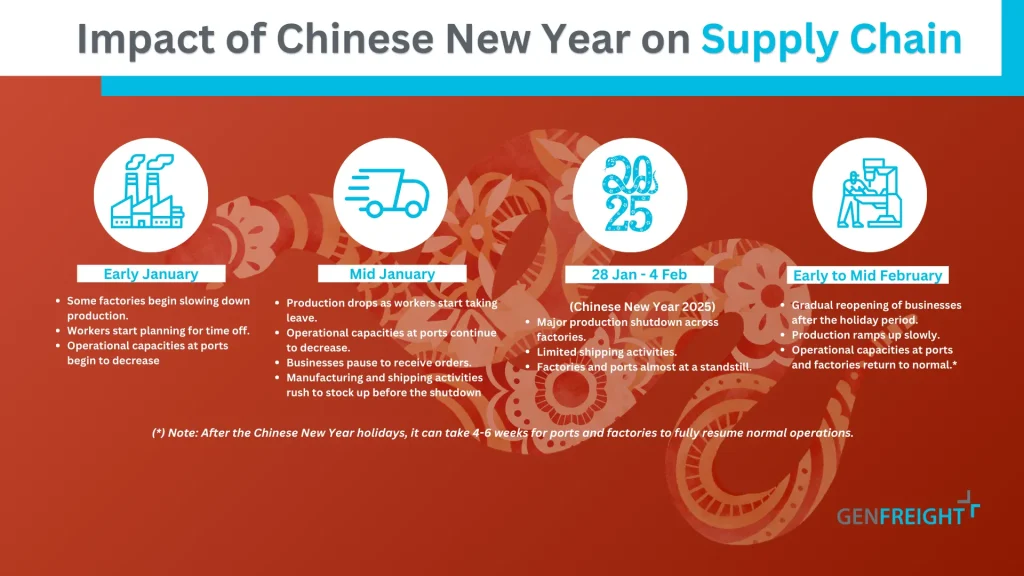Chinese New Year, also known as Lunar New Year, is a significant global event celebrated across Asia and beyond. This vibrant festival, marked by parades, fireworks, and family gatherings, holds immense cultural importance for billions of people. From Vietnam (Tet) and Malaysia to Singapore, the Philippines, and beyond, communities come together to celebrate this joyous occasion.
However, for businesses involved in trade with China, particularly Australian companies, Chinese New Year presents a unique set of challenges. Traditional factory closures, reduced workforce, and potential shipping disruptions during this festive period can significantly impact supply chains. This year, the earlier-than-usual start of Chinese New Year, following closely on the heels of the Christmas season, creates an even tighter planning window for businesses to navigate these potential disruptions.
Undoubtedly, the impact on supply chain of Chinese New Year extends beyond China’s borders. Also, as a major manufacturing hub, China plays a crucial role in global supply chains. Disruptions in Chinese production can create ripple effects, affecting trade routes in Southeast Asia and delaying global supply chains. Therefore, understanding these challenges and planning ahead is essential for Australian businesses to keep operations smooth. Moreover, it helps ensure goods are delivered on time during and after the Lunar New Year holiday.

Key Dates and Timeline for Chinese New Year 2025
Chinese New Year 2025, the Year of the Snake, officially begins on January 29th. While public holidays typically run from January 28th to February 4th, the impact on supply chains extends well beyond these dates. Many factories and businesses experience extended closures, often lasting up to six weeks. Finally, the Lantern Festival, celebrated on February 12th, usually marks a return to more normal operations.
To ensure smooth logistics, it’s crucial to adhere to specific deadlines. Document cut-off dates for shipments and pickups typically fall within 3-7 days prior to the intended shipping date, depending on the mode of transport (sea, air, or road) and the specific region (Greater China, Vietnam, Taiwan, etc.).
The lead-up to Chinese New Year often sees a gradual slowdown in production. Factories and trucking firms typically release workers a week or more before the official holiday, leading to a decline in production capacity and potential transportation delays. To mitigate these challenges, some companies may implement adjusted working schedules, such as weekend shifts on January 26th and February 8th, to maximise production before and after the holiday period.
So by understanding this timeline and incorporating these key dates into your logistics planning, Australian businesses can better navigate the potential disruptions associated with Chinese New Year 2025.
Impact on Supply Chain
Chinese New Year 2025 will undoubtedly have a significant impact on global supply chain. Here’s a breakdown of the key challenges:
- Factory Shutdowns:
- Firstly, many Chinese factories will experience complete shutdowns or significantly reduced operations during the holiday period.
- As a result, this directly translates to delays in order fulfillment, impacting production schedules. Also it potentially leads to missed deadlines for Australian businesses.
- Freight Transportation Rates:
- Moreover, the surge in shipping demand before the holiday typically leads to a sharp increase in freight transportation rates.
- Therefore, peak-season surcharges and General Rate Increases (GRI) are commonly announced by shipping carriers closer to the holiday. As a result it adds to the overall cost of transportation.
- Port Congestion and Shipping Delays:
- Additionally, pre-holiday demand often leads to container shortages and severe congestion at major Chinese ports.
- Also, post-holiday, carriers may implement blank sailings to adjust capacity. Furthermore, this impacts shipping schedules and potentially causes delays in cargo delivery.
- Labor Shortages:
- Besides, workforce reductions across the supply chain, including factory workers and transportation personnel, can lead to slower post-holiday operations. In addition, this can worsen delays even further.
- Industries Most Affected:
- Finally, industries that rely heavily on Chinese manufacturing, such as electronics, textiles, and toys, are likely to face disruptions. Moreover, the automotive sector may experience some of the most significant challenges during this period.

Additional Considerations of impact on supply chain:
- Air Freight Delays. Firstly, after the holiday, air freight operations may face delays as workers return and systems gradually resume normal operations. Therefore, businesses should expect some delays.
- Rail and Road Services. Secondly, rail and road services in China and nearby countries may encounter issues due to holiday leave and higher transportation costs. As a result, transport times could be affected.
- Southeast Asia Impact. Thirdly, operational challenges may arise in neighboring countries like Vietnam, including reduced warehouse shifts and slower transport movements. For instance, these issues could lead to delays in deliveries.
- Diversification Strategies. Moreover, to reduce risks, Australian businesses can consider using alternative ports in Southeast Asia and exploring different transportation modes. In particular, diversifying ports may help avoid congestion.
- Spring Festival Migration. Lastly, the annual Spring Festival migration of Chinese citisens significantly strains transportation resources, which may lead to further delays. Consequently, businesses may experience longer shipping times.
Preparing for CNY 2025 and Minimising the impact on supply chain
Proactive planning is crucial for Australian businesses to navigate the challenges of Chinese New Year 2025. Here are some key strategies:
Planning Ahead and Communication:
- Early Communication. Firstly, etablish open and consistent communication with your logistics provider well in advance of the holiday.
- Aligning Expectations. Secondly, clearly align expectations regarding timelines, costs, and service levels to avoid misunderstandings and potential disruptions.
- Sharing Forecasts. Thirdly, share your production and shipping forecasts with your vendors to enable them to better plan their operations. Also it will help to minimise potential delays.
Pre-Booking Shipments:
- Reserve Space. Also, secure vessel space or book less-than-container loads (LCL) well in advance to ensure timely transportation.
- Booking Timelines. Moreover, adhere to recommended booking timelines, which can vary depending on the region. For instance, allow 2 weeks before vessel departure for shipments from Greater China and up to 3 weeks for road transport.
- Book Early. Additionally, book ocean freight 3-4 weeks in advance whenever possible. For urgent shipments, consider air freight or premium LCL services.
Inventory Management Strategies
- Analyse Historical Data. Furthermore, analyse historical data to identify critical items and adjust inventory levels accordingly.
- Split Shipments. On top of that, consider splitting shipments across multiple bills of lading. As a result it mitigates the risk of rolled cargo due to port congestion.

Diversifying Shipping Routes and Modes:
- Explore Alternatives. Also explore alternative ports and transportation methods, such as air freight or intermodal freight. As a result it increases flexibility and reduce reliance on congested sea routes.
- Less-Congested Ports. Moreover, consider using less-congested Chinese ports like Xiamen as alternatives to Shanghai and Shenzhen.
- Port of Discharge Flexibility. Additionally, maintain flexibility in selecting the port of discharge to avoid bottlenecks and ensure timely delivery.
Creating a Just-In-Case Shipping Budget:
- Contingency Funds. Furthermore, set aside contingency funds to cover unforeseen costs such as demurrage, detention, and potential cargo damage.
- Buffer Timelines. Lastly, build buffer time into your shipping schedules to account for potential delays and unforeseen circumstances.
Additional Tips:
- Pre-Alerts. In addition, send pre-alerts or draft pre-alerts for imports to specific countries like Vietnam to expedite customs clearance.
- Consider Longer Transit Times. What’s more, consider services with slightly longer transit times to avoid overbooked routes and minimise potential delays.
- Engage Logistics Experts. Finally, engage with experienced logistics provider early in the planning process to secure capacity and leverage their expertise.
Long-Term Lessons from Chinese New Year
Chinese New Year, while presenting challenges, also offers valuable opportunities to refine supply chain resilience and adaptability.
- Continuous Improvement. Firstly, view each Chinese New Year as an opportunity to analyse and learn. For example, identify areas for improvement in your supply chain planning and execution.
- Diversification Strategies. Secondly, diversify your supplier base to reduce reliance on a single source and mitigate the impact of potential disruptions. Also explore alternative sourcing options and consider nearshoring or onshoring strategies.
- Enhanced Communication. Thirdly, cultivate strong and open communication channels with your suppliers and logistics partners throughout the year. For example, share forecasts, anticipate potential challenges, and work collaboratively to find solutions.
- Contingency Planning. Moreover, utilise past Chinese New Year experiences to develop robust contingency plans for future disruptions. For instance, this could include alternative shipping routes, emergency inventory stockpiles, and flexible production schedules.
- Proactive Risk Management. Additionally, implement proactive risk management strategies, such as pre-alerts for imports and continuous monitoring of supply chain trends. Moreover, leveraging technology to identify potential disruptions early on can further enhance preparedness.
- Technology Adoption. Finally, embrace technology to enhance supply chain visibility and improve forecasting. For instance, use tools such as blockchain, AI, and data analytics to monitor real-time data, identify potential risks, and make informed decisions.

Looking Ahead: Opportunities During CNY
While the holiday period presents challenges, it also offers unique opportunities for businesses:
- Strengthening Relationships. Firstly, utilise the slower periods during Chinese New Year to strengthen relationships with suppliers and partners. For example, engage in face-to-face meetings (virtually or in-person) to foster trust and explore collaborative solutions.
- Focus on Improvement. Also, leverage the reduced operational tempo to focus on internal process improvements, such as streamlining workflows, optimising inventory management, and implementing lean manufacturing principles.
- Workforce Development. Moreover, invest in workforce training and development during slower periods. So this could include upskilling employees on new technologies, improving communication skills, and enhancing risk management capabilities.
- Strategic Planning. Additionally, use the slower periods for strategic planning initiatives, such as identifying alternative suppliers, developing contingency plans for future peak periods, and exploring new market opportunities.
Conclusion
Undoubtedly, Chinese New Year, or Lunar New Year, is a time of profound cultural significance across Asia, marked by celebrations, family reunions, and a renewed sense of optimism. While this festive period presents unique challenges, the insights provided in this article can equip Australian businesses with practical strategies to minimise impact on supply chain.
At GenFreight Global Logistics, we understand the complexities of navigating global supply chains, particularly during high-impact events like Chinese New Year. Our team of experienced logistics experts can provide valuable guidance and support, from optimising shipping routes and managing inventory to developing robust contingency plans.
We offer a comprehensive suite of services designed to enhance your supply chain resilience, including:
- Real-time visibility and tracking: Gain real-time insights into the location and status of your shipments.
- Proactive risk management: Identify and mitigate potential disruptions before they impact your operations.
- Expert consultation: Access our team of experienced logistics professionals for personalised advice and guidance.
- Tailored solutions: We develop customised solutions to meet your specific needs and budget.
Contact GenFreight Global Logistics today to learn how we can help you navigate the challenges of Chinese New Year and ensure the smooth flow of your goods throughout the year.
